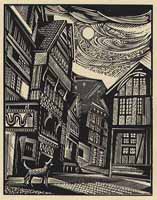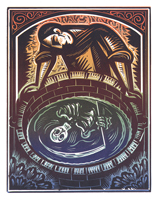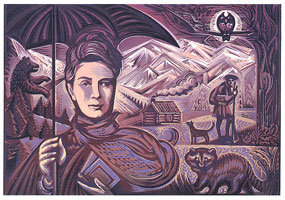BLACK AND WHITE PRINTS
A wide range of images exemplifying Stephen Alcorn’s penchant for translating complex themes
into visual signs, patterns, and rhythms that can effectively be cut and/or engraved.
Price range: c. $100 - $300, depending on dimensions of print.
Sample of technique:

Howling at the Moon
(also featured in the Folklore category)
DARK OVER LIGHT PRINTS
In these prints two or more colors are printed in the traditional manner of relief-block printmaking,
which consists of printing dark tints over light tints.
Price range: $150 - $400, depending on dimensions of print, and on number of colors employed.
Sample of technique:

Sabina Reading
(also featured in the Self Portraits/Family category)
LIGHT OVER DARK PRINTS
The delicate quality of the dark lines and the transparent quality of the overall surface of these prints is achieved by reversing the traditional cutting and printing technique and thereby printing the principal block in a semi-opaque white over a previously printed dark background. By cutting away areas of the dark background the white of the paper is permitted to function as highlight
Price range: $200-500, depending on dimensions of print,s and on number of colors employed.
Sample of technique:

The Finish Line
(also featured in the Folklore category)
RAINBOW INKINGS
Through the manipulation of color with palette knives and rolling techniques, gentle, painterly
gradations of tone, akin to those of a rainbow, are achieved.
Price range: $150-500, depending on dimensions of print, and on number of colors employed.
Sample of technique:

The Wishing Well
(also featured in the Folklore category)
REDUCTION PRINTS
A reduction print is made with the use of a single block. Through a series of progressive cuttings, inkings, and printings, the image slowly emerges while, paradoxically, the actual block is destroyed. A reduction print can therefore never be reprinted. All reduction prints are finite and are limited to 12 -18 prints per edition.
Price range: $250 - $1000, depending on dimensions of print, as well as on the size of the edition.
Sample of technique:

Isabella Bird, Rockie Mountain Explorer
(also featured in the Miscellaneous Portraits category)
Words of Praise
"Not since the Belgian master Frans Masereel (1889 - 1972) has
an artist reached such elevated heights in the art of printmaking"
-Daniele Baroni, Critic and Art Historian
From the cover story entitled The Art of Stephen Alcorn
Linea Grafica, Number 296; Pg. 10-19; Milano, Italy; 1995
"Stephen Alcorn relishes the challenges inherent in the linocut print, pushing them and exploiting them
to achieve effects that are truly ground breaking and uniquely his. Indeed, his investigation of the linocut
medium has been a kind of odyssey in which each discovery has led to a new vision, and the territory to
be explored is apparently boundless"
-Carol Stevens, Executive Editor, Print Magazine
Excerpt from the cover story entitled
Choice Cuts: Stephen Alcorn’s favored technique is the linocut . . .
January-February, 1994; pg. 32-41
"Whether he's interpreting the face of a famous author like
Solzhenitsyn, illustrating with impeccable skill and sharp irony a scene
from Malraux's Man's Hope, or taking on an entire novel, such as Paul
LaFarge's The Artist of the Missing, there's no question that Stephen
Alcorn is one of our most technically sophisticated and inspired of
artists. The sheer craftsmanship is breathtaking, revealing a kind of
artistry that hasn't existed for half a century, nearly obsessed with
clean lines, the interplay of light and dark, the myriad possibilities
offered by a centimeter of space, a delight in structure, design and
texture. But more than the technique is the imagination and visual
acuity Alcorn brings to his subjects: playing with perspectives,
jostling with angles, combining foreshortened, exterior scenes with
larger, emotional interiors, setting our expectations on head so we
look, and look again, and marvel. This is multi-dimensional work in the
true sense of the term: layered, split-imaged, resonating with
multiple--sometimes complementary, sometimes contradictory--meanings,
brilliantly executed, unfailingly interesting. Throughout his oeuvre
Alcorn has lifted "the veil of familiarity," to use the phrase
popularized by Wordsworth and Coleridge when stating the mission of the
romantic poets. We see the world anew through his eyes, and remain,
always, the richer for it."
-John A. Glusman Vice President & Executive Editor, Farrar, Straus & Giroux

